#Unitary Operator
Explore tagged Tumblr posts
Text
Unitarity
Introduction Unitarity, a principle central to quantum mechanics and quantum field theory, is the mathematical expression of the fundamental conservation law in these theories – the conservation of probability. At the most basic level, it guarantees that the total probability of all possible outcomes of a quantum mechanical system is always one. The Basics: Unitary Operators In the language of…
View On WordPress
0 notes
Text

20240918
0 notes
Text
Perfect.
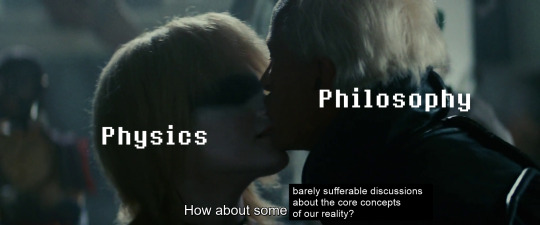
@requiem626k
#ahxjsnxms i love that we’ve started to talk about this as a literal ship#i hate shipping in actual franchises yet i love shipping abstract stuff#last week i told a friend half-jokingly about how unitary operators are girls hermitian operators are boys and how i shipped them#he was like hhshxjjsnxNSNXJSSMWnsnxn???#but anyways yes. i fancy the concept and give you my 100% support in this business Lav#also don’t worry about responding late!!#i myself will start my spring semester this monday and will have to withdraw myself again for a while 🥲#i wish you the best luck with your work <3#physphil#ship name 👍🏻
12 notes
·
View notes
Text
Hugo Lowell at The Guardian:
Donald Trump has said that he has instructed the justice department to fire any remaining US attorneys installed by the previous administration, in an apparent move to stamp out political appointees of Joe Biden who might resist having Trump’s agenda guide prosecutorial decisions.
“I have instructed the termination of ALL remaining ‘Biden Era’ US Attorneys,” Trump wrote in a Truth Social post on Tuesday. “We must ‘clean house’ IMMEDIATELY, and restore confidence. America’s Golden Age must have a fair Justice System – THAT BEGINS TODAY!” The dismissal of US attorneys after a change in administration is typical, although the Trump administration has been unusually aggressive in pushing for mass firings across the board as opposed to asking for their resignations shortly after the new president takes office. It also comes as Trump’s attorney general, Pam Bondi, and acting deputy attorney general, Emil Bove, have moved to implement the administration’s political agenda at the justice department and their vision of the unitary executive theory, where the president directs all cabinet-level agencies. In recent days, Bove, as the number two official overseeing day-to-day operations, pushed through the dismissal of the corruption case against the New York City mayor, Eric Adams, pending a review of the case by Trump’s pick to run the US attorney’s office in Manhattan once he is confirmed by the Senate.
Donald Trump orders the mass firings of all Biden-appointed US attorneys in a power grab.
128 notes
·
View notes
Text
THE FACTORY.
Regular steps clang rhythmically on the floor of an area not yet surveyed in Sector XC5Delta9.
The sound of SERVE's heavy silver military boots spreads powerfully and full of obedience.
A patrol of SEALED DRONES, led by the highest-ranking unit, SERVE-425 has the mission to gather all the information and proceed with the activation of the necessary consequent operational protocols.
The Visual System of each Drone scans every inch of a large dark covered area in which there are old machinery, but apparently in operation.
The visual and acoustic data detected lead to identify the place as an active industrial plant, but significantly dated and with limited production capacity.
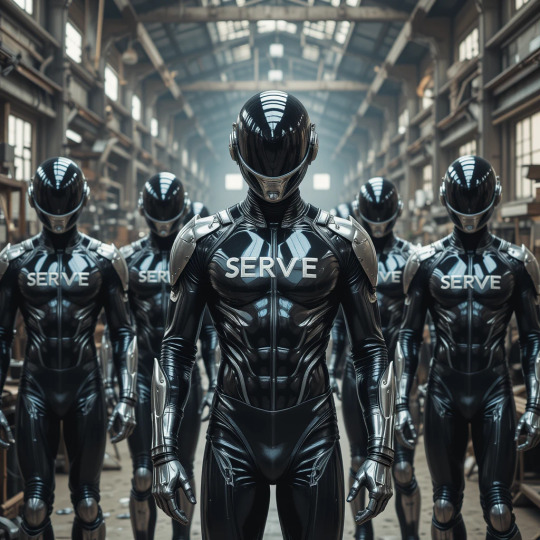
The irrevocable judgment was that the plant was highly suboptimal in the organization of the spaces, in the equipment of machinery, in the overall production cycle.
Attracted by the sound and the powerful images of shiny black Rubber with heavy silver military metal boots and long silver metal gloves, faceless because they are equipped with a shiny black faceless helmet, who were moving around with a unitary, robotic attitude, devoid of any audible form of communication, a group of workers in old work clothes approaches curiously and hesitantly.

They stand around the group of Drones, waiting to know who they are dealing with. It is at that moment that SERVE-425, flawless in its perfect muscular rubberized power comes forward with a single precise step that sounds resolute and firm.
" Connection established.
SEALED DRONES Patrol detects high level of inefficiency in this Facility.
Explanation Required."
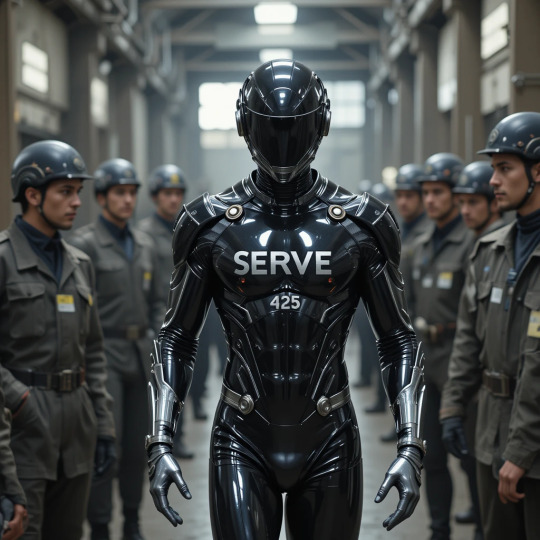
A little doubtful, one of the workers managed to understand and began to tell how the factory is destined to close soon, which is why the owners are not proceeding with the renewal of machinery and production lines, dooming everything to a miserable end and the workers to a tragic lack of wages in the near future.

Now devoid of a purpose and a perspective for the future, they live by poorly producing the product, living day by day and waiting for a miracle to help them.
It is at that point that SERVE-000 sends the order to activate the Recruitment and salvation protocol.
425 addresses the humans, now resigned to nothingness, with a monotonous robotic voice:
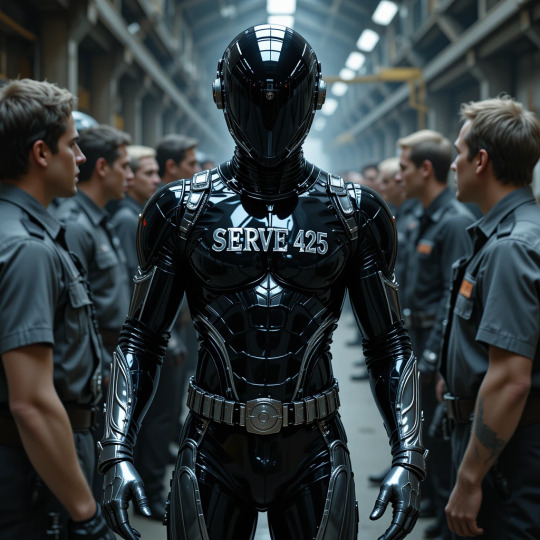
" Error Detected.
Humans always have the path to Salvation.
SERVE will bring Salvation through Obedience.
SERVE offers opportunities for PURPOSE, OPTIMAL EFFICIENCY.
A new existence free of uncertainties and doubts.
Rubber will bring ORDER and PURPOSE."
Follow the PATROL."
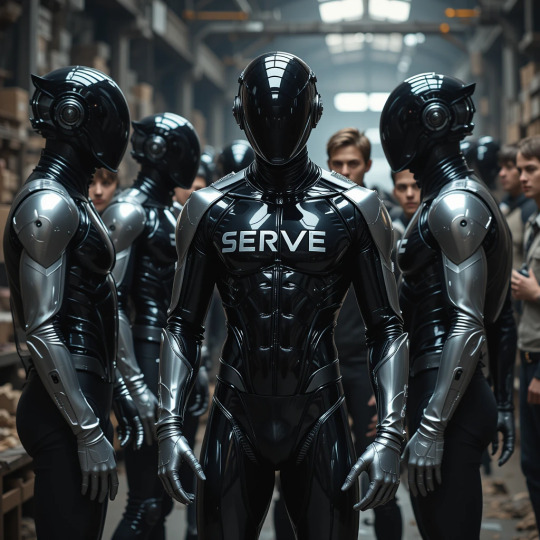
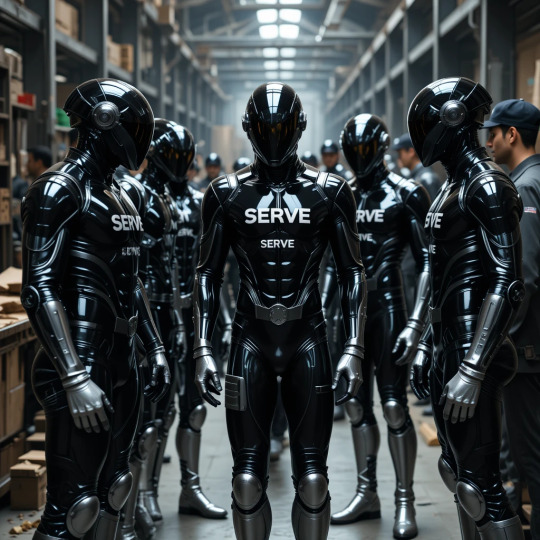
Looking into each other's eyes, the men began to follow the Drones' steady, unyielding steps toward a shiny black tent that had been quickly set up outside the factory.
They had no idea who had set up the tent, but the promise of a new life free of hardship and uncertainty guided them confidently and serenely.
One by one, the disheveled, tired, disillusioned men entered, the tent closed behind them.
No resistance, no repentance.

A few weeks later, the grim old factory that was about to die had been replaced by a shiny futuristic metal structure where the components needed for the CONVERSION PODS to function were produced.
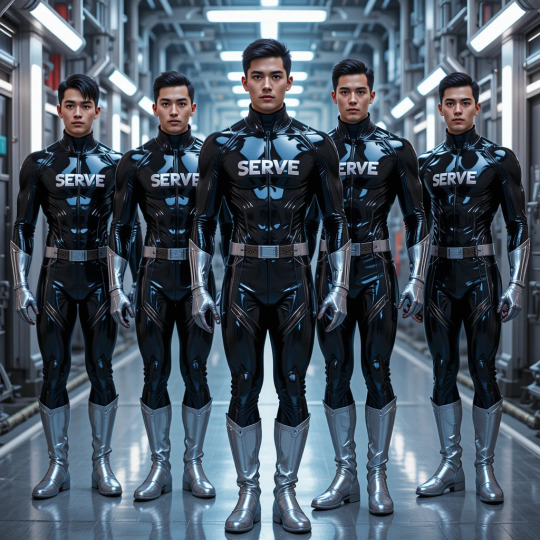
No longer workers, but muscular, statuesque, efficient and essential Drones entirely devoted to the PURPOSE performed the necessary calibrated actions.
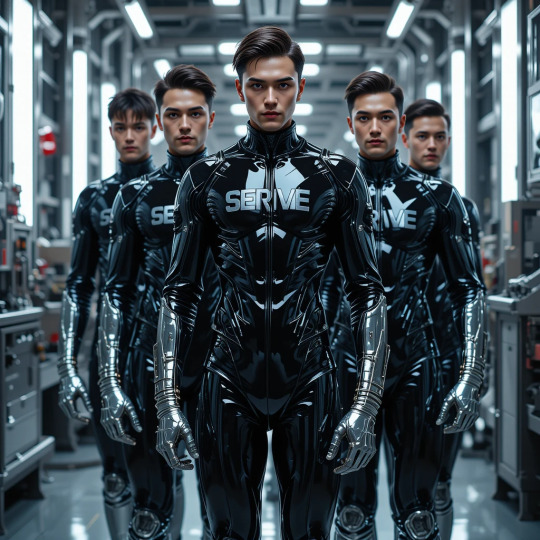
None of the Drones had any memory of their previous sad condition. Obedience and Pleasure were the watchwords.

In this story: @rubberizer92 @serve-425
Your place in the Hive awaits. Contact a recruiter drone for more details: @serve-016 @serve-302, or @serve-588, @serve-425.
24 notes
·
View notes
Text
When you study math for 100 million billion years like me you start forgetting the easier things and only remember the advanced stuff

@greetings-inferiors idk how to say this without seeming stupid so ill just say it. i dont know how differentiation works anymore.
#like i barely know what 7*8 is without a calculator#anyway its fine lol i usually have the opposite problem#where ill talk about operators and mention 'clearly the left shift on \ell^\infty is an isometry but not unitary' to first year students#and theyll be like sir what the shit are you talking about
110 notes
·
View notes
Text
Donald Trump’s cronies are threatening to defy the authority of the federal courts. If they follow through, the nation’s rapid descent into dictatorship will be complete, and the risk of the first challenge to the legitimacy of the federal government since the Civil War could soon be upon us.
Over the past several weeks, Trump and consigliere Elon Musk have embarked on an unprecedented barrage of illegality, including an attempt to destroy whole government agencies and misappropriate (and likely misuse) government and personal data on a massive scale. In the face of compliant Republican majorities in both houses of Congress, the only brakes on the MAGA crime spree have come from a handful of federal judges who have issued injunctive decrees prohibiting some portions of the criminal scheme.
In recent days, Trumpers have engaged in bad faith efforts to evade some of the judicial constraints. But there are limits to the effectiveness of that strategy. And other orders they cannot fake complying with — such as the ruling keeping Treasury data out of Musk’s hands — have clearly made Trumpers’ blood boil.
Hence the now open threats by Musk, his sidekick Vice President JD Vance, and others to challenge the proposition — which has been foundational to our constitutional structure since 1803 — that the courts have the exclusive power to decide what the Constitution and laws of the United States mean and require, and can issue orders that bind everyone else (including the president) to comply.
The first failed imperial presidency
In the wake of Watergate, Richard Nixon famously told David Frost that “when the president does it, that means that it is not illegal.” Nixon’s declaration that the president is the arbiter of legality flew in the face of the longstanding principle of judicial review providing that the judiciary has exclusive power to decide disputes over the nation’s Constitution and laws.
Nixon had a personal bone to pick with that principle, because it was an order by the Supreme Court requiring him to turn over evidence that brought his would-be imperial presidency crashing down.
Nixon had attempted to bring the Watergate investigation — and in particular, a subpoena for White House tapes — to a halt by firing prosecutors. HIs gambit ultimately failed, culminating in a Supreme Court ruling ordering him to turn the tapes over. Among them was the so-called “smoking gun” recording that caught Nixon directly engaged in what (until very recently) would have been deemed criminal presidential conduct.
Nixon might well have defied the Court’s ruling. But, unlike Trump today, he understood that most Republicans in Congress would not support him. He ultimately turned over the tapes, and, shortly thereafter, relinquished the White House. As his later remarks to Frost made clear, however, he left power believing that he had been wronged, as did many of his partisans.
During the decades after Watergate, a number of rightwing politicians and scholars (including future AG Bill Barr) focused on devising ways to increase the power of Republican presidents. They did so in the hope of arming Nixon’s Republican successors with the tools to avoid having their power limited, let alone being driven out of office.
This cohort advanced what came to be known as the “unitary executive” theory. It posited that because Article II vests executive authority in the president, the president himself has sole and exclusive authority over the operation of every executive branch agency, and therefore the power to abuse their authority.
Barr’s now-infamous “audition” memo, which he prepared before being named as Trump’s second attorney general, reflected a then-audacious (but now almost mainstream) version of the unitary executive theory. He argued, among other things, that Trump had plenary authority to order the Justice Department to terminate investigations of himself and his cronies, as well as to commence them against his political adversaries — proposals Barr implemented once he took office, including by seeking to engineer the termination of a criminal case against Michael Flynn after he had pled guilty.
Trump, who ultimately concluded that Barr had an insufficiently robust view of executive power, is now calling on AG Bondi to create entire units of the DOJ to harass, and potentially prosecute, his political opponents.
The unitary executive theory also posited that independent agencies such as the Federal Reserve Board and Federal Election Commission are unconstitutional, and that the president can direct their operations freely. Trump has enthusiastically adopted this position, including most recently by ignoring the appointment rules that govern the Federal Election Commission by purporting to fire its Democratic chair.
Additionally, since the Nixon administration, rightwing advocates for presidential power have argued that the president’s executive authority permits him to simply refuse to spend funds appropriated by Congress to effectuate policies the president disapproves of.
In 1974, Congress enacted the Impoundment Control Act, which purports to place guardrails on such actions. Once again, Trump and his current crew – including Musk and Project 2025 author and OMB boss Russ Vought — are openly defying such limitations on presidential authority, including by unilaterally dismantling duly established government agencies.
The judicial review fig leaf
Critics of the unitary executive theory have long argued that it is merely a pseudo-scholarly pretense for implementing Nixon’s previously frustrated vision of the imperial presidency, and thereby transforming the office into a dictatorship.
Unitary executive advocates, however — at least until recently — vehemently disagreed, pointing to their putative support for Congress’s lawmaking authority and the principle of judicial review. Unitary executive advocates were not, so they claimed, actually advocating for Nixon’s position that anything a president does is legal because they recognized and upheld the principle of “judicial review,” and thus the courts’ role in determining whether a president’s actions are constitutional and otherwise legal.
The principle of judicial review is not stated in any provision of the Constitution. Instead, it was announced by then Chief Justice John Marshall in the 1803 Marbury v. Madison decision — a brilliant example of politically astute judicial power-grabbing.
In Marbury, Marshall ruled that his own court-packing effort in his previous job as President John Adams’s Secretary of State had failed in one instance. William Marbury, whom Marshall and Adams wanted to install on a lower court, had not received a document called a commission in time, Marshall ruled, thereby allowing Thomas Jefferson, Adams’s successor in the White House, to keep Marbury off the bench.
Bu in order to reach that ruling in Jefferson’s favor, Marshall ruled that it was the federal courts’ exclusive prerogative to decide disputes over the meaning and proper application of the Constitution and laws of the United States. The immediate result was that a federal judiciary packed with Federalists (the party of both Adams and Marshall) became a check on Jefferson’s power. The longer term impact was to give the federal judiciary power to define the mandates of the Constitution and federal laws that could be used for good (as in Brown v. Board of Education) and evil (as in Plessy v. Ferguson).
In the decades after the Civil War, the Supreme Court was a reliably conservative adversary against progressive policies. But, beginning in the 1930s — after a standoff with FDR and change in the Court’s composition — the Supreme Court began to be viewed as an instrument of liberal public policy (including in Brown, as well as in Roe v. Wade) and therefore as an institutional adversary of Republican presidents.
Yet, following Watergate, Republicans have embarked on an increasingly brazen scheme to pack the federal courts — and particularly the Supreme Court — with rightwing extremists, their hope and expectation being that the jurists they installed would use their power of judicial review to advance Republican policies and presidents. In this way they could transform the courts into both a sword and a shield. And the strategy has succeeded, likely far beyond their greatest hopes.
Approaching the brink
The scheme has worked particularly effectively in recent years. The Court’s rightwing supermajority is effectively serving as a Republican branch of government and has been increasingly open to validating Trump’s overreaches — most notoriously in the immunity and Insurrection Clause decisions that effectively paved the way for his return to the White House and encouraged his abuses of power.
In addition, the Court seems poised to continue to issue rulings blessing most if not all of Trump’s efforts to make the unitary executive theory a political reality, including by endorsing his destruction of independent agencies. The only exceedingly modest price Trumpers had to be willing to pay was to accept a few rulings adverse to some of Trump’s most outrageously illegal actions.
The smart move would be for Trump and his cronies to grudgingly accept those rulings and at least make a pretense of complying with them. After all, courts are not equipped to micromanage the activities of presidential appointees even in the cases of openly malign actors like Musk and Vought. And once these matters reach the Supreme Court, many if not most of Trump’s actions are likely to be upheld by a Court now chock full of his cheerleaders.
In fact, if Trumpers were modestly savvy, they would recognize that the occasional high profile loss in the Supreme Court is ultimately beneficial to their cause, since they allow the Court’s rightwing justices to maintain a pretense of independence.
But despite the extraordinary benefits that Trumpers have derived from the pliant and partisan Court that Mitch McConnell packed for them, they’ve never hidden their dissatisfaction, particularly at the fact the federal courts did not validate Trump’s efforts to overturn the outcome of the 2020 election. Now, in the face of the injunctions that have placed modest limitations on their crime spree, Trumpers have declared that they are prepared to challenge the principle of judicial review and attempt to transform the presidency into an actual dictatorship, with no enforceable limitations on its exercise of power.
The dark irony of this brazen power grab is that it is hugely self-destructive to Trump and Trumpism. Given the brazenness of his actions, Trump more than ever needs his Supreme Court majority to come through for him and lend a veneer of legitimacy to his actions, even if doing so comes at the cost of clipping his wings along the edges.
If Trump proceeds in open defiance of the courts he will risk turning the huge asset of a politicized rightwing Supreme Court into a liability. More importantly, Trump may call into immediate question the legitimacy of his own authority — legitimacy the Supreme Court has lent to him through key rulings it bent over backwards to issue in his favor.
A Trump without that veneer of legitimacy offered by the judiciary will end up, like his idol Vladimir Putin, as a “strongman” who can remain in office solely and entirely based on the threat of force. The question, then, could become whether military and law enforcement authorities will be “loyal” to a leader who has shed even the pretense of constitutional legitimacy.
It’s disturbingly easy to envision a situation where Trump’s assault on the nation’s constitutional order rapidly changes from a cold to a hot war, just as occurred in the middle of the 19th century. But the costs to the nation and to the world of such a conflict in the 21st century could be even higher than they were back then.
19 notes
·
View notes
Text

WIND TUNNEL TEST OF INLETS
The inlet configuration, operational performance, and bypass control pressure schedules were developed during a test conducted over seven weeks at the NASA Ames Unitary Wind Tunnels at Moffett Field, California.
The inlet configuration was developed at the design Mach number of 3.2 in the 8 X 7 foot leg of the wind tunnel and then the data filled out through the flight envelope in the 8 X 7 foot, 9 X 7 foot, and 11 foot wind tunnel legs.
The inlet model was 1/8th scale. The scale was small so that the vehicle forebody could be included with the inlet model. This was done in order to capture the forebody flow distortions and effects in the inlet data.
I also read that the nearby town kept losing all their electricity because the wind tunnels use so much of it. There was nothing to spare as far as electricity. Kelly Johnson used windtunnel experiments constantly that was one of his secrets to success..
@Habubrats71 via X
#sr 71#sr71#sr 71 blackbird#blackbird#aircraft#usaf#lockheed aviation#skunkworks#aviation#mach3+#habu#reconnaissance#cold war aircraft
9 notes
·
View notes
Text
The Tech-Bros learned the wrong lesson?
Despite existing in the same digital communities; tech bros and gamers seemed to have learned the wrong lesson about leadership.
To this point; we've had technologies all developed for hobbyists ability to pick-up and run with it.
Overtime, the [skill-issue] crowd has determined that skill and ability are a kind of [divine providence].
Also, despite understanding the difference between [Casual] and [competitive] {environments}.
In gamer terms; Hard-Core players are like Bleeding-Edge Developers. They're trying to be {world-first} or just {develop their skills} or {just trying to do difficult and cool skateboard tricks}.
In the "Casual" environment, e.g; "Players that don't care about the depth of the underlying system" or "Just playing for fun" or for devs "Just doing odd jobs for a quick buck" is where Politics *should* be.
If the system can't be picked up by your average user and ran with... It's not a good system.
Because of that [Skill-Issue] {ideology} we've got a lot of players that think they're the [Top Shit] playing completely on public servers.
I'd liken it to [LeBron James] or [Tom Brady] deciding that they need to dominate [K-12]{or amateur} sports in order to get ahead in their [chosen careers].
I'll let you consider LeBron James unironically dunking on amateur players as if that was why he was the best player in Basketball. And that's where our Politics and Technology environments *are* right now.
Should-be professionals destroying the environment the casuals are just trying to *do their job, get paid and go home to their real hobbies*.
And they're unironically supportive of this "Unitary" ideology. Because they think that *should* be the norm.
Any shift worker or technical expert will explain to you the purpose of [positive turn-over] and the detriments of relying on [one expert] too heavily.
Tech-Bros? They want ONLY the one expert they can exploit, because they all think they're the [One Bro to Bro them all] or whatever.
That is how the cutting edge, the hardcore environments work sure; but that's not sustainable NOR scalable for the casual environment.
And we have both for a reason. Because the Hardcore environments have serious drawbacks when you find yourself operating at the level.
High-risk, Low-reward {in comparison to expended effort}, employee burn-out; high turn-over with low positive turnover rates.
And we are seeing Tech-Bros reinvent the casual environment as if it were Hardcore Competition Environment.
Employment at that level isn't supposed to be *that* competitive. That's what the Hardcore environments is *for* and why things keep breaking when you get bored of your Hyperfixation.
It's not because you're the only ones who can do the thing, it's because you've put the casual stuff in the PvP zones. Intentionally creating a game loop that requires predatory behavior in order to advance.
In the casual environment, or for the newbies, you should be able to pick up [The whatever] and just roll with it, while skilled people and those understanding the in-depth details are literally playing a different game in a different environment.
thats not design; That's how community and government works. And has been optimized over generations and thousands of years.
Ye, Some of that shit can be improved; Reinventing the wheel successfully doesn't happen that often though. The last really important Wheel reinvention was Galvanized Rubber after-all.
I would posit that y'all not only know better; you're intentionally designing an environment which exalts {not competition} but [rabid destructive behaviors] as a method to make profit.
Job Security shouldn't be [knowing certain buzzwords]. It's poor cryptography at best.
9 notes
·
View notes
Text
oh btw i dismantled your boyfriend on a quantum level. yeah... i acted on him as a unitary operator... information cannot truly be destroyed but you can only infer the person he used to be by the scattered fragments that remain. uh huh. he's preserved in classical and quantum mechanics but without true omniscience you're not getting more than a blurry estimate lol. hey are we still on for brunch btw
8 notes
·
View notes
Text
As of 22:00 on May 16, EEST, the operational lines of the Department for Documentation of War Crimes of Ukraine received information about damage as a result of shelling by the Armed Forces of Ukraine of the cities of the Republic:
N.p. Gorlovka (Kalinin district):
Dropping of explosives from a drone at 03:30: Branch of the State Unitary Enterprise of the DPR "Voda Donbassa" Water Filtration Station No. 1 on Dneprovskaya Street.
Information about the consequences of the shelling continues to arrive. The extent of damage is yet to be confirmed
3 notes
·
View notes
Text
Wavefunctions never collapse completely
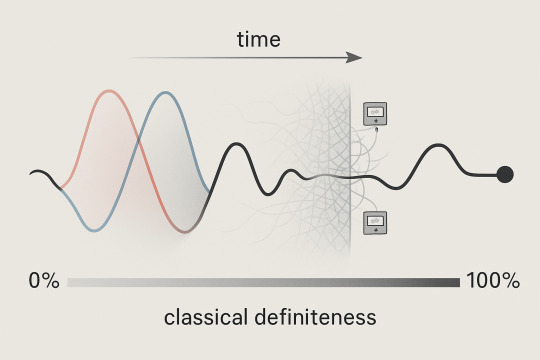
In quantum mechanics, the concept of a "measurement being complete" is not defined by the formalism itself. The equations — such as the Schrödinger equation — never say, "now the system has collapsed into a definite outcome." Instead, they describe continuous, unitary evolution. Collapse, in this view, is not an event inside the mathematics but a boundary we draw when we interact with the system in a certain way and choose to interpret the result classically.
In quantum computing, this distinction becomes operational. The machine must eventually produce a classical result — a bitstring — even though it has been processing coherent quantum states. But when exactly does that transition happen? The system evolves and interacts with a detector, which is itself a quantum system, and begins to entangle with it. This interaction spreads the quantum information into more and more degrees of freedom: first into the readout device, then into an amplifier, then into a voltage signal, then into a data register.
The longer this process is allowed to proceed, the more entanglement accumulates, and the more irreversible and classical-like the outcome appears. In practical terms, this means: the longer we let the detector run, the more confident we become that a classical outcome has effectively emerged. Not because the wavefunction has objectively collapsed, but because the amplification and environmental interaction have washed out the coherent alternatives to such an extent that no further quantum interference is possible.
Thus, "measurement complete" is a judgment made by the observer, based on the stability and reproducibility of the signal. It is a pragmatic boundary, not a sharp physical event. We act as though a classical bit now exists — and for all experimental purposes, it does. But underneath, the quantum process may have simply flowed into the world, becoming so complex and inaccessible that interference is practically impossible. This view resonates with Bohr’s insight: even in a quantum world, measurement must be described in classical terms — not because the world is classical, but because our access to outcomes is.
2 notes
·
View notes
Text


Theory and Data: the implications for anarchism
In general, one may say that for every principle about humans and human nature that has been made by anarchists one can find in the anthropological literature both substantiation and disproof. There is, however, a growing consensus among anthropologists about certain ideas pertaining to humanity that would please any anarchist. First, let us consider what might be called the principle of the biological unity of the human species.
For some time antedating the rise of anthropology as a distinct discipline and extending down to recent times as part of the history of anthropology itself, there has been a struggle between monogenetic and polygenetic theories of the origin of homo sapiens. Polygenetic theory argued for the divergent origins of the so-called races of humans. Emphases upon differences in appearance and differences of origin of human groups have been employed to buttress arguments about the superiority or inferiority of such groups. If one claims that Black people are mentally inferior to whites, then it is of considerable help to usher in evidence which presumably demonstrates that the foundation stocks of the two populations are totally unrelated. Monogenetic theory, by contrast, argued that all humans are one species sharing a common ancestral line. Today, this is a prevailing view in anthropology. Variations among present populations are seen as a consequence of the biological process of adaptation but any such variation amongst humans is of very minor significance and involves at best only a handful of genes which relate to such factors as hair form, the amount of bodily hair, presence or absence of an epicanthic fold on the eye, skin pigmentation, overall bodily form (whether lanky or squat) and height, head form and various facial features.
Forty years ago, practically every anthropologist agreed that the human species was divisible into races, although there was little agreement as to how many races there were. Today this view is no longer so widely held, and an increasing number of anthropologists hold that homo sapiens is a unitary species which may have local variation, but such variation does not justify classification into separate races (subspecies). Briefly, the argument for this point of view is as follows:
a) Certain allegedly racial characteristics such as head shape and bodily height are too affected by environmental factors to serve as the indicators of race they once were used for.
b) There is an incredible amount of overlap and mixing between populations. Races are at best 'ideal types'. They are a summary of certain presumed genetic traits which tend to be prevalent in some populations. Yet any given individual within that population may not have all these traits or even a few of them. Thus, a broad flat nose is presumably a characteristic of West Africans, but there are some West Africans with narrower noses than some Norwegians.
c) It has already been noted that so far as we know none of the so-called racial features is of much significance, especially in the contemporary world as far as adaptation and survival are concerned. Perhaps under aboriginal conditions a squat, blocky frame with lots of subcutaneous fat adapted the Inuit or Chukchi better to an extremely cold climate. But clearly as cultures have changed and become increasingly the mechanisms by which humans adapt to the physical environment this biological feature loses importance. Scandinavians, for example, lack these qualities and have lived in the northern extremes of Europe foe 2000 years with great success. It probably should be stressed that intelligence is not a factor which can be associated with any alleged races. It cannot be said for an absolute certainty that there are no variations amongst 'races' in intelligence because so far no one has devised a proper culture free test which could examine native or inborn intelligence, nor has anyone offered an adequate operational definition of race which could be used in such testing.
d) The term race had been so politicised and transformed into an ideological term that it has muddled its use for biological purposes. Race today has far more serious implications for humankind as a political and ideological tool that it probably ever had as a biological reality. For these reasons many would abandon the use of the term race in relation to humans while, of course, continuing to investigate the bio-genetic variations that do occur within the species.
To sum up, anthropological data seems to show that humans are a single species with common ancestry. If it is possible to say the species is divisible into some kinds of races, any differences are of very minor importance. Whether one travels to the middle of the Amazon Basin, or amongst Australian Aboriginals or citizens of Moscow, one will find in each of these populations a normal range of intelligence: a few dimwits and a few geniuses with a goodly majority just average sorts.
#Africa#anthropology#England#English politics#epigenetics#field trip#genetics#Kenya#Kenyan politics#Malawi#Malawian politics#Uganda#Ugandan politics#Zimbabwe#Zimbabwean politics#music#Pëtr Kropotkin#poetry#Ruth Finnegan#The Raven#travel#africa#african politics#anarchism#anarchy#anarchist society#geopolitics#resistance#autonomy#revolution
2 notes
·
View notes
Text
Ahmed Baba at Ahmed Baba's Newsletter:
The biggest battles over President Trump’s agenda and executive overreach aren’t occurring in the halls of Congress - they’re happening in the courtroom. Donald Trump and Elon Musk’s DOGE team have been ignoring laws, unilaterally attempting to dismantle agencies, accessing sensitive data, sidelining civil servants, and testing the limits of executive power. This has been nothing short of an outright power grab, seeking to accomplish the core goal of the modern right-wing movement and Project 2025: to break down the federal bureaucracy and reshape the federal government into a tool of the far-right. Congress, with the Senate and House in Republican control, has done nothing to check the Trump Administration’s abuses of power. In spite of this administration’s effort to unilaterally seize the power of the purse away from Congress and to shut down congressionally-created agencies, Republican lawmakers have been largely silent or compliant. While the Legislative Branch fails in its duties to uphold the constitutional principle of separation of powers, the Judicial Branch is stepping up to the plate. [...] On Sunday, Vice President J.D. Vance joined the attacks on the federal judiciary, posting on Twitter, “If a judge tried to tell a general how to conduct a military operation, that would be illegal. If a judge tried to command the attorney general in how to use her discretion as a prosecutor, that's also illegal. Judges aren't allowed to control the executive's legitimate power.” Elon Musk quote-posted Vance’s comments with American flag emojis. Vance, who graduated from Yale Law School, knows his claim that judges “aren’t allowed” to review executive power is pure nonsense. Having attended Yale, Vance is very aware of the Supreme Court’s 1803 Marbury v. Madison ruling, which established judicial review and cemented the judiciary’s authority to check the power of the other two branches of government. An administration like Trump’s is precisely why the Founders created our coequal system of checks and balances, designing the judiciary specifically to check this kind of power grab. This expansive view of executive power aligns with the unitary executive theory, which I’ve written about extensively. It’s the theory that Article II of the Constitution renders the president an all-powerful figure above accountability and checks on their power. The theory can be summed up in President Richard Nixon’s infamous words: “Well, when the president does it, that means that it is not illegal.” Or, in Donald Trump’s more precise words, “Then I have an Article II, where I have the right to do whatever I want as president.” As I’ve outlined, the Trump Administration is deliberately pushing the bounds of executive power. They believe the Supreme Court will further expand Trump’s power, as they did in their immunity ruling. But now, Vance and Musk are upping the ante with their attacks on the power of the judiciary itself.
With various courts blocking the unlawful moves by the Trump-Musk-Vance triumvirate of evil, JD Vance and Elon Musk launch attacks on judicial authority with the intent to plunge the US into a constitutional crisis.
See Also:
Daily Kos: Trump seems to think he can just ignore court orders he doesn't like
Public Notice: Trump and his lawyers embrace the logic of dictatorship
#Authoritarianism#Elon Musk#Donald Trump#J.D. Vance#Trump Administration II#Musk Coup#Separation of Powers#Unitary Executive Theory#Marbury v. Madison#Judiciary#Project 2025
11 notes
·
View notes
Note
I think Wickard v. Filburn was pretty clearly a massive overreach but I also approve of the move towards a more unitary United States, so ???
I have a long response to this, but I have spent too much of my workday on Tumblr as it is and so I will save it for tomorrow. But the short version of my thesis is that Wickard v. Filburn is a bad decision on legal grounds, but that it's the kind of bad decision you are forced into if you refuse to adopt a Living Tree notion of your Constitution and refuse to make it easy to amend. You can try to have a static, unchanging Constitution and keep the country the way it was in 1787 forever, but States Gotta State, and so if you make it impossible for them to do this in an explicit way, then they have no choice but to do it in crazy ways like Wickard v. Filburn. In a legal realist sense, there is no chance that states will continue to be bound by Constiutionalist conventions of centuries ago if that makes it impossible to operate in the modern world, and the things which Filburn authorized are necessary to operate in the modern world.
19 notes
·
View notes
Text
(Al-Akhbar English) Federalism Resurfaces: What Will the "New Syria" Constitution Look Like?
As Syria deals with the aftermath of regime collapse and a constitutional vacuum, fears of partition are resurfacing amid power struggles and divided interests. Hay’at Tahrir al-Sham (HTS), led by Ahmad al-Shar’a, has solidified control by establishing an interim government tasked with overseeing key areas of governance until March. This temporary governance phase has reignited concerns over a partition plan, fueled by competing factions vying for control of Syria’s resources, with Israeli interests factoring into the equation. The proposal seeks to divide Syria into sectarian and ethnic regions, making a national dialogue that prioritizes unity essential to prevent fragmentation.
Certain factions are pushing for partition plans disguised as calls for administrative decentralization in Syria’s new constitution. Proposed federal divisions would grant Damascus the status of capital while limiting its power over local regions. Aleppo would become a commercial hub, while Idlib-Hama forms a unified identity. Homs would be diverse and civil-oriented, while Daraa and Suwayda would reflect Jordanian influence. Deir ez-Zor and Raqqa would become tribal regions, and Hasakah would be under US control to secure the eastern borders, with US control over oil fields and Israeli occupation of Quneitra continuing.
While these partition plans remain largely theoretical, actions on the ground appear to align with them. In Suwayda, armed factions, under the guidance of Druze leader Sheikh Hikmat al-Hijri, have attempted to seize control of the city. This move followed a phone call between al-Hijri and his Palestinian counterpart Sheikh Mowafaq Tarif, and local factions reportedly received instructions from US officers at the Al-Tanf base to prevent HTS from advancing into Druze-majority Suwayda.
In parallel, Syrian Democratic Forces (SDF) advanced into Deir ez-Zor, filling a gap left by retreating Syrian forces, while also raising concerns about a resurgence of ISIS. However, HTS later pushed into Deir ez-Zor, forcing the SDF to retreat. Attacks, such as the one on Manbij, signal an effort to restrict SDF operations to the east of the Euphrates. Kurdish sources have expressed fears that the Autonomous Administration’s influence could be limited to Hasakah, compelling the SDF to withdraw from Raqqa and Deir ez-Zor, leaving vital oil fields under the control of Syria’s interim government.
As the drafting of Syria’s new constitution intensifies, opposition sources suggest the process is becoming more complex. While HTS rejects the Syrian Opposition Coalition (the National Coalition for Syrian Revolutionary and Opposition Forces) as a political entity, it allows its leaders to enter in a personal capacity. This has raised concerns over al-Shar’a’s government monopolizing the process. The source adds that Al-Shar’a "is trying to convince engaged countries to draft a constitution establishing a unitary Syria with centralized governance and broader powers for governors.” Such a move raises fears of centralizing power, mirroring the former regime’s control over resources, politics, and education, while also increasing concerns about Islamization among civil and political groups.
Full report in Arabic: Full report in Arabic: https://al-akhbar.com/arab/816827
3 notes
·
View notes